The Universe, Space Sectors & Resource Management
2021. July 21.
Welcome to the Voidfall Design Spotlights!
We are very happy to kick off the Design Spotlight series with today's first entry for Voidfall, a space 4X euro game designed by Nigel Buckle and David Turczi, and illustrated by Ian O'Toole!
Mindclash Games' fifth original title is coming to Kickstarter this Fall. Each Wednesday starting from today and up until the campaign launch, the designers of Voidfall will discuss certain aspects and mechanisms of the game, and how they tie into the game’s story and universe.
Please note that while Voidfall has already undergone extensive playtesting and development, it is still a work in progress, so anything you see and read here may be subject to change. We are looking forward to many exciting discussions with you under each entry on boardgamegeek.com!
Without further ado, let's kick things off with a never-before-seen image of a 4-player competitive setup of Voidfall!

An introduction to the universe of Voidfall
Voidfall’s story takes us to Domineum, a feudalistic galactic empire ruled for centuries by the Royal House of Novarchon. The empire is a coalition of countless human Great Houses, each with different traditions, ethics - and sometimes even physical appearances. While the central Houses are ruled with an iron fist by House Novarchon, those in the fringe worlds enjoy a greater autonomy at the cost of lower life standards and technology level.
As a leader of one of these fringe Houses, you always believed that humanity is alone in the galaxy. Rumors of House Novarchon’s strange belief in an otherworldly being called the Voidborn were just a myth to your people, until one day the grim prophecies proved true: a portal to the Voidborn’s dimension opened in Novarchon space. Sweeping through it was a force of pure corruption, turning the bodies and minds of the Novarchons and the central houses, who had secretly been obeying its whispers for decades, into mere thralls of the Voidborn.
So far, the distant fringe Houses have been safe from the Voidborn’s initial wave of corruption, but you know with a grim certainty that it won’t stop until it corrupts every single human being in the galaxy, and destroys all who resist. It now falls upon you and your fellow fringe Houses to unite, fight your way to the heart of Domineum and close the portal before the Voidborn fully manifests in our dimension. Only when this immediate threat has been repelled can you aspire to defeat the remaining Voidborn forces and restore the ravaged Domineum as its new Ruling House - even if it requires facing your former allies.
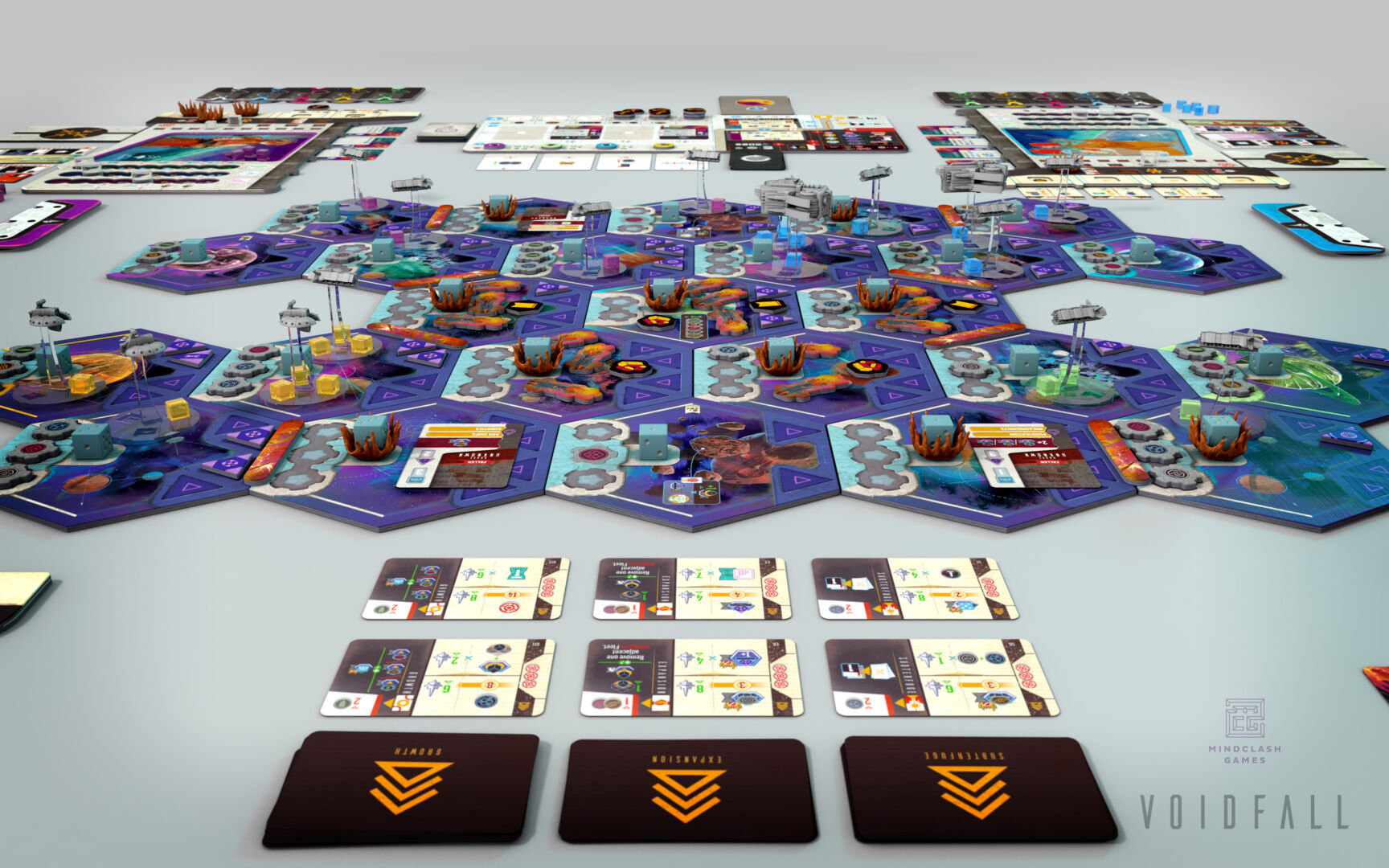
Voidfall is a 4x space empire building game that can be played cooperatively (playing the story of the epic struggle of closing the Voidborn portal) or competitively (playing the story of purging and restoring Domineum, and the rivalry of becoming its new Ruling House). In both game modes, the Voidborn is a formidable adversary, intertwined with nearly every game system. Besides fighting its forces, you are also trying to resist its corruption that threatens to affect various aspects of your empire - but embracing it also holds the promise of power…
In each of these design spotlights, we will cover one of the game’s core mechanical aspects. Today, we are starting with the basic building blocks of every proper space 4x game: the space sectors of Voidfall.
Space Sectors
Space sectors are hex shaped tiles representing astrometrical and administrative regions of the Domineum, so one sector could mean one or more planets, a huge wormhole or even an entire asteroid field. You’ll choose and build a map out of these tiles during game setup - a slice of the Domineum where the fight for the future is to take place.
Here is what we call a standard sector:
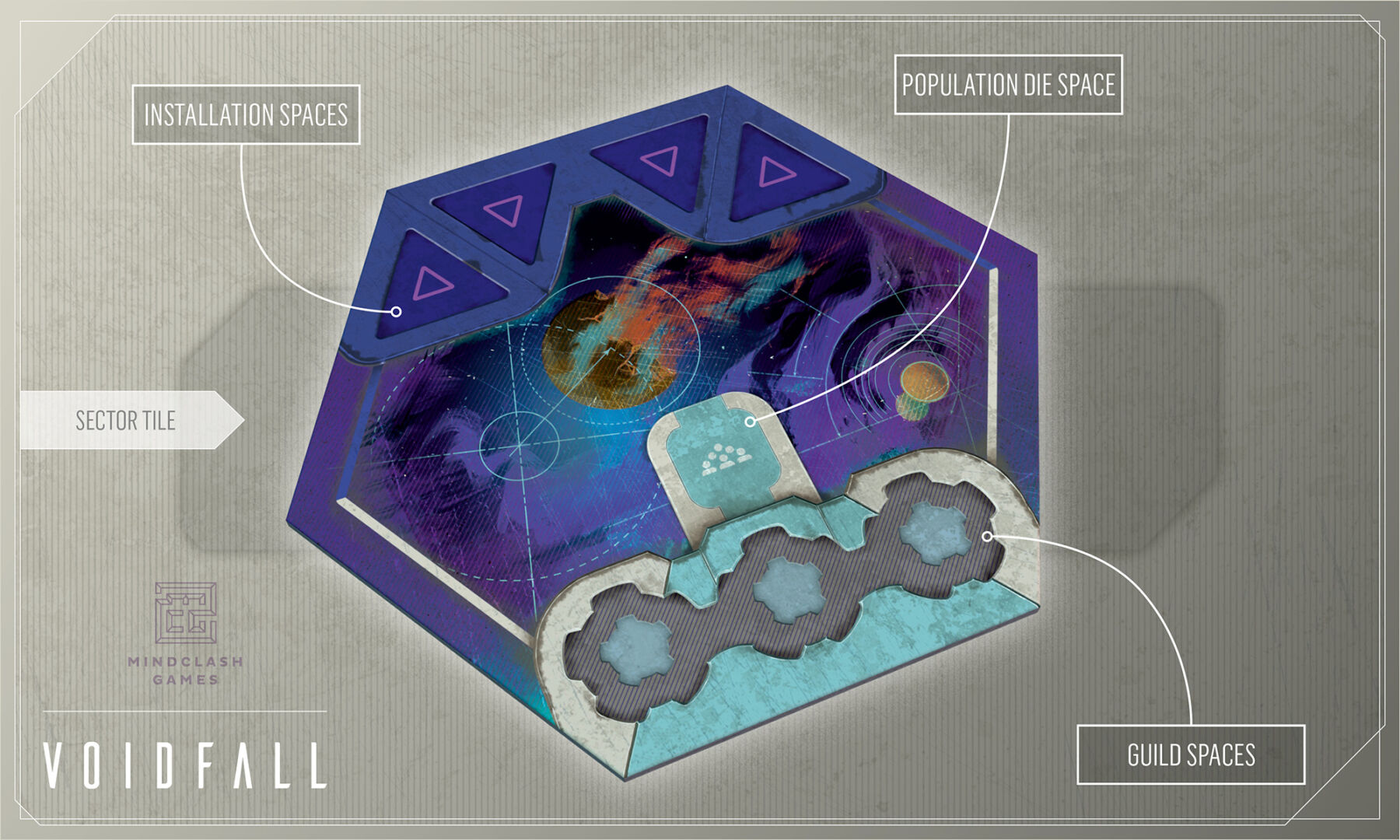
This type of sector is what your House will interact with the most at the start of a game. First thing to notice is the central area with a population icon; this is where a die is placed to represent the population level of the sector (so runs from 1 to 6). The higher the number the more populous and valuable the sector: higher population means more efficient production. Standard sectors can also become Corrupted by the Voidborn, which we will cover in more detail in an upcoming Spotlight.
And here is a glimpse at your future safe haven, your Home sector:
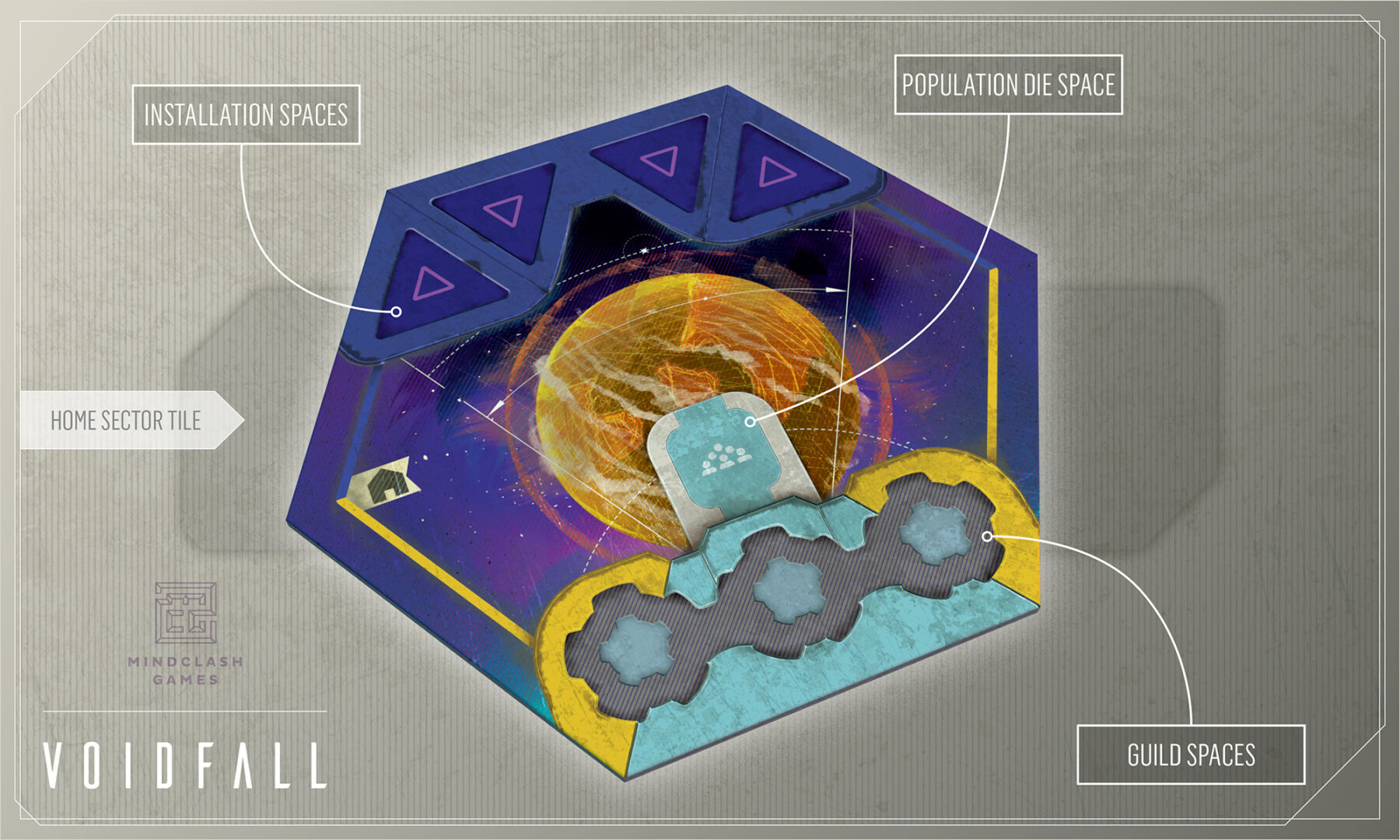
As you can see, your Home sector is marked by your player color. This sector is part of your starting setup, giving home to your starting Infrastructure and space fleets, and will never be attacked or corrupted by the Voidborn. However, the price of this safety is its remoteness. Increasing population here is hard, and deploying fleets here will be a long way from the frontlines…
Using the benefits of the modular space hexes, Voidfall offers many different map setups for different player counts and interaction preferences: if you and your gaming group is more into competing in efficiency and empire building, you’ll find map setups with low aggression level; but if you feel challenging your friends is more like your style, you will love “knife fight in a phone booth” style high aggression maps. And to spice things up, many unique special sectors are waiting to be discovered in certain map setups. Just to name (and show) a few, the Asteroids house a permanent Guild (see later) and boosts your fleet deployment, the incorruptible Paradise World boosts all your resource production, and all sectors adjacent to the Vortex are considered adjacent to each other as well.
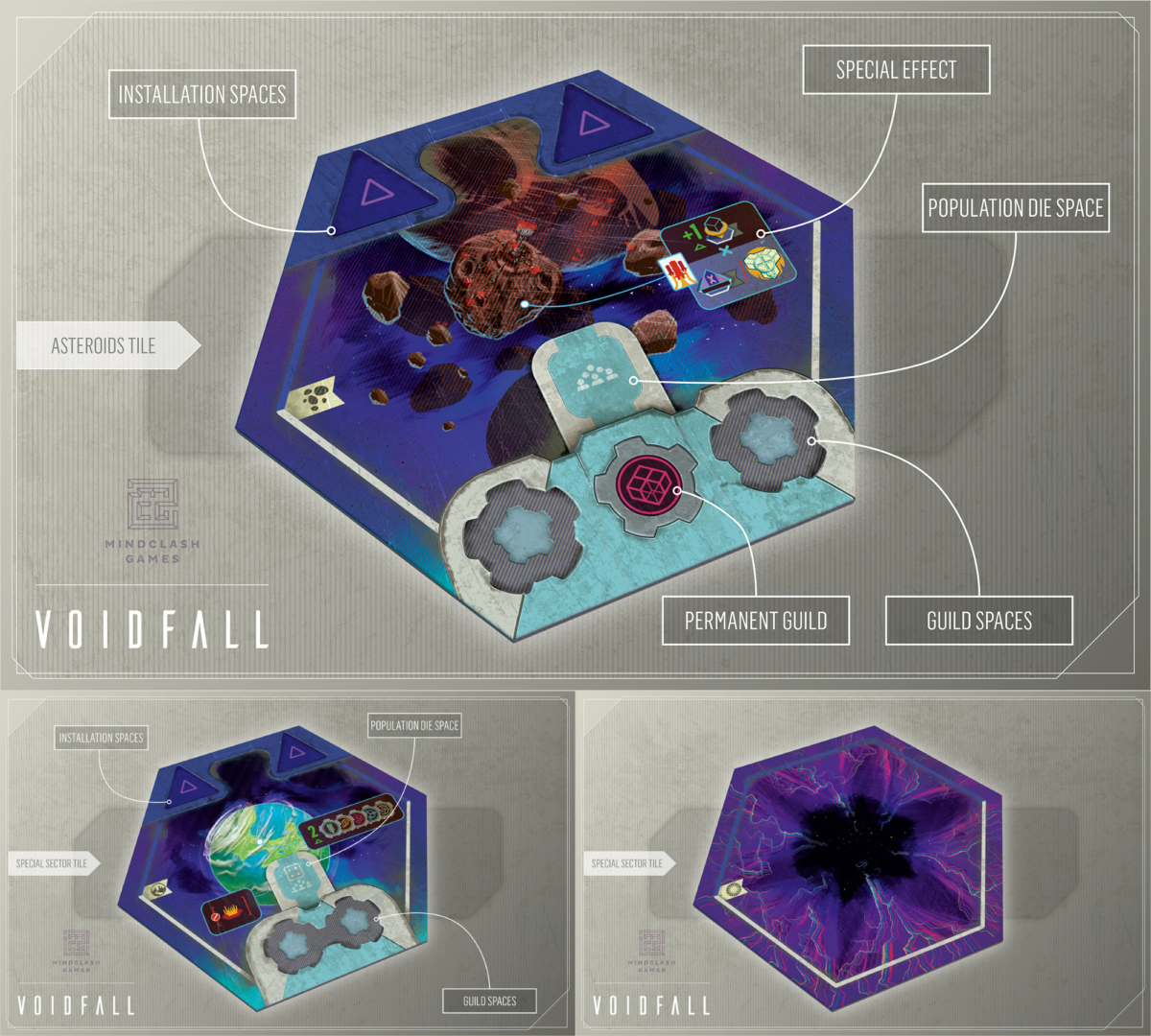
Expanding in Voidfall
Voidfall is a space 4X-based euro game, and here is the first instance where you can see an X in action: expanding. If you wish to build a bigger empire there are two main vectors to approach this by: are you going to expand “sideways” into more space and control more sectors (usually the choice of the player with the bigger gun) or are you going to expand “upwards'' by increasing your population and building more Infrastructure, thus making your existing sectors more efficient?
You will see throughout the series of the Design Spotlights how we are attempting to redefine the implementation of a 4X experience through the eyes of a strategic euro game. Central to the strategy gamer’s mind are high-level decisions that can be engaged with differently each play to ensure replayability. The first question you’ll face several times during play: do you want more sectors or do you want better sectors?
Infrastructure
To improve a sector, you also need Infrastructure besides population. Infrastructure can appear in two ways: it can either be a civilian Guild or a military Installation, and each type has their own limited number of spaces on a sector. Once you have filled a sector with Infrastructure, you will need to expand to new sectors should you wish to develop further.
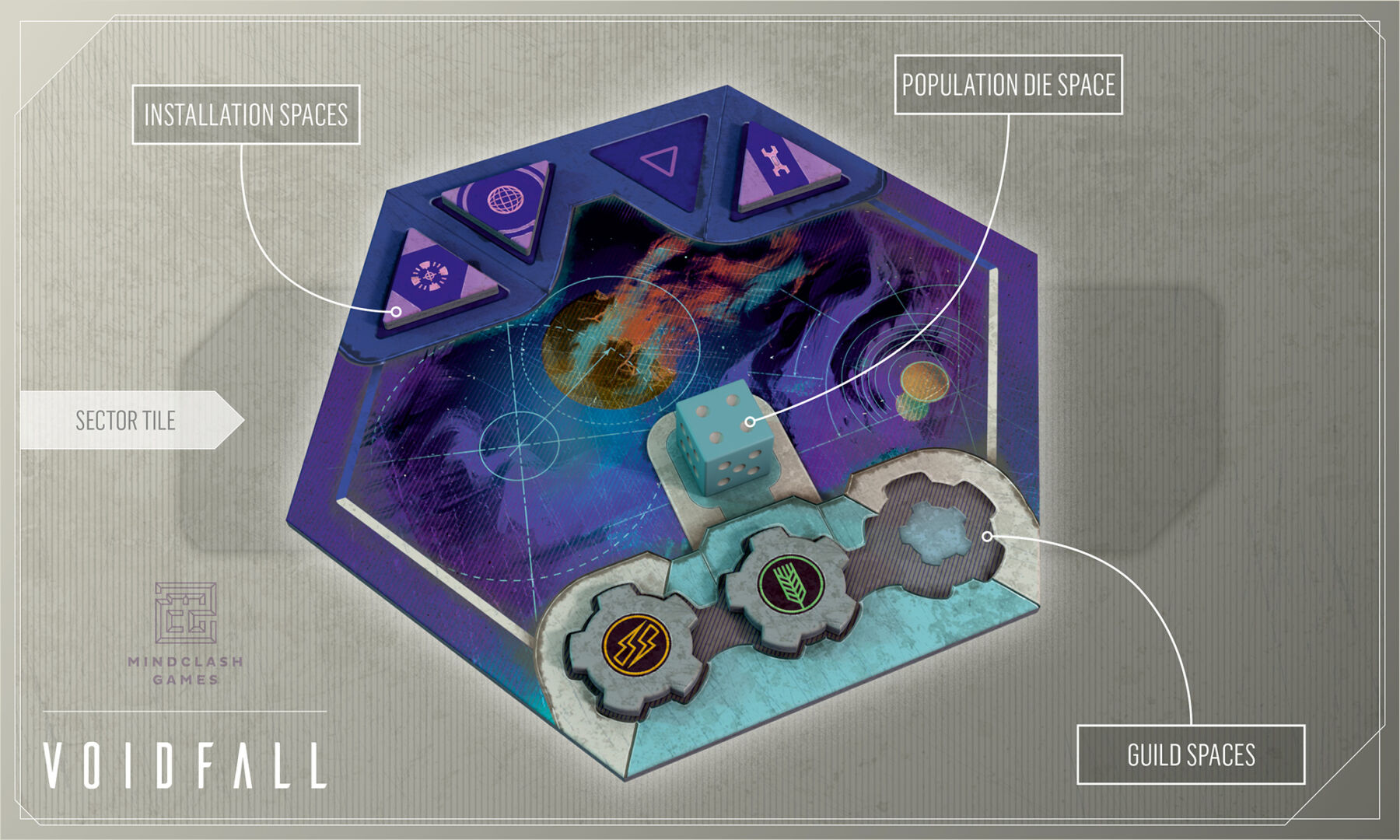
Guilds and Production
In Voidfall, Guilds are the pillars of your economy, representing the various experts and the technical assets needed to produce resources. A Guild established in a sector doesn’t just mean a group of workers or a building, but a whole network of assets on an interplanetary scale. You can establish a Guild by placing a Guild token onto a cog shaped Guild space on a sector. There are five types of Guilds, each responsible for the production of one certain type of resource:
- Farmers Guild is responsible for supplying your House with food of natural origin
- Engineers Guild employs technicians who provide energy for your fleets and your House’s technical needs
- Miners Guild produces materials for building your interplanetary infrastructure and space fleet
- Scientists Guild brings together the greatest minds in your House to bring you science and research capabilities
- Bankers Guild is basically the banking network of financial experts that grants you credits, a wild resource to replace food, energy or materials.
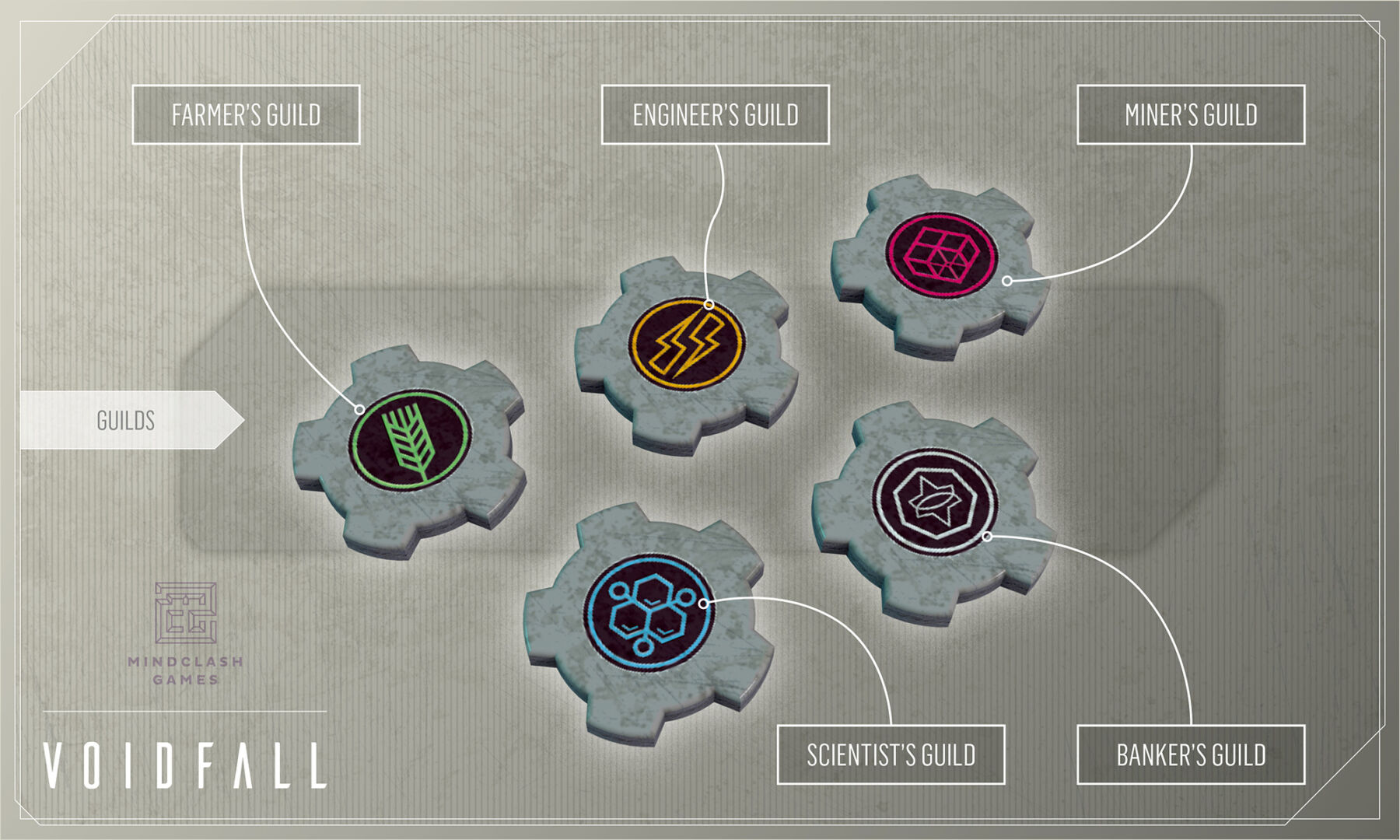
In the feudalistic empire of the Domineum where the technology is unevenly developed, the efficiency of production is still heavily dependent on your people. When you produce one type of resource, each Guild of that type under your control contributes to your total gain based on the population of the sector it is established in. You track your production levels on your dials: increase it for each population of each matching guild you have.
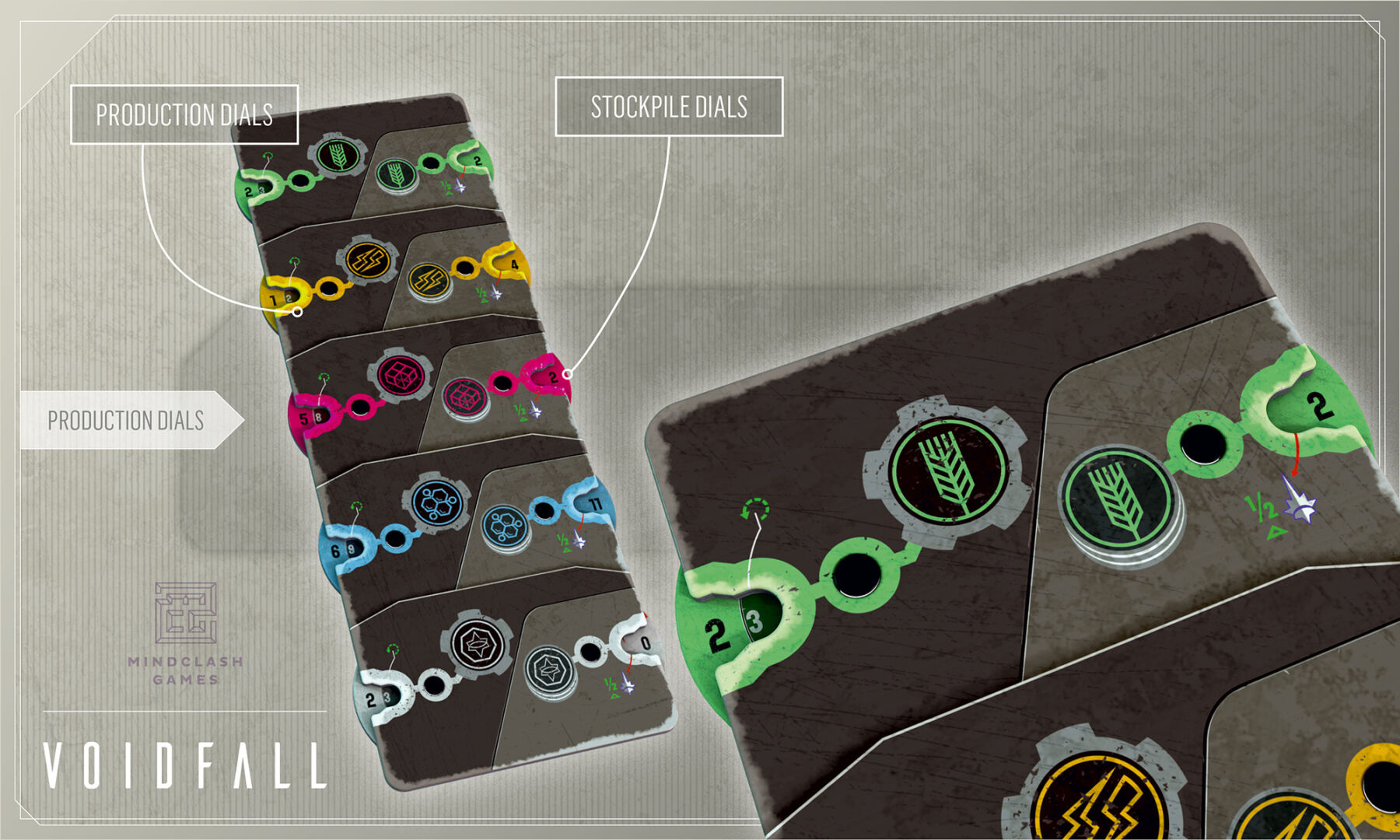
You'll notice the production dials on the left side show two numbers for each production type - how many steps you have increased, and how many resources you will actually gain. This is because production is not linear: overseeing a large number of Guilds and/or highly industrialised, populous sectors will result in much more efficient resource productions. The right side of your dials also show your five stockpiles, opposite of the matching production: when you produce resources they are stored on these wheels and you can then spend from these resources to power your actions.
First step towards the exploitation of your empire is creating resource production: as you establish Guilds in your sectors, you increase the production of that resource type for each of the sector's current population. If you later increase the population level of a sector, then you increase all the production values for the types of resources that sector houses a Guild for.
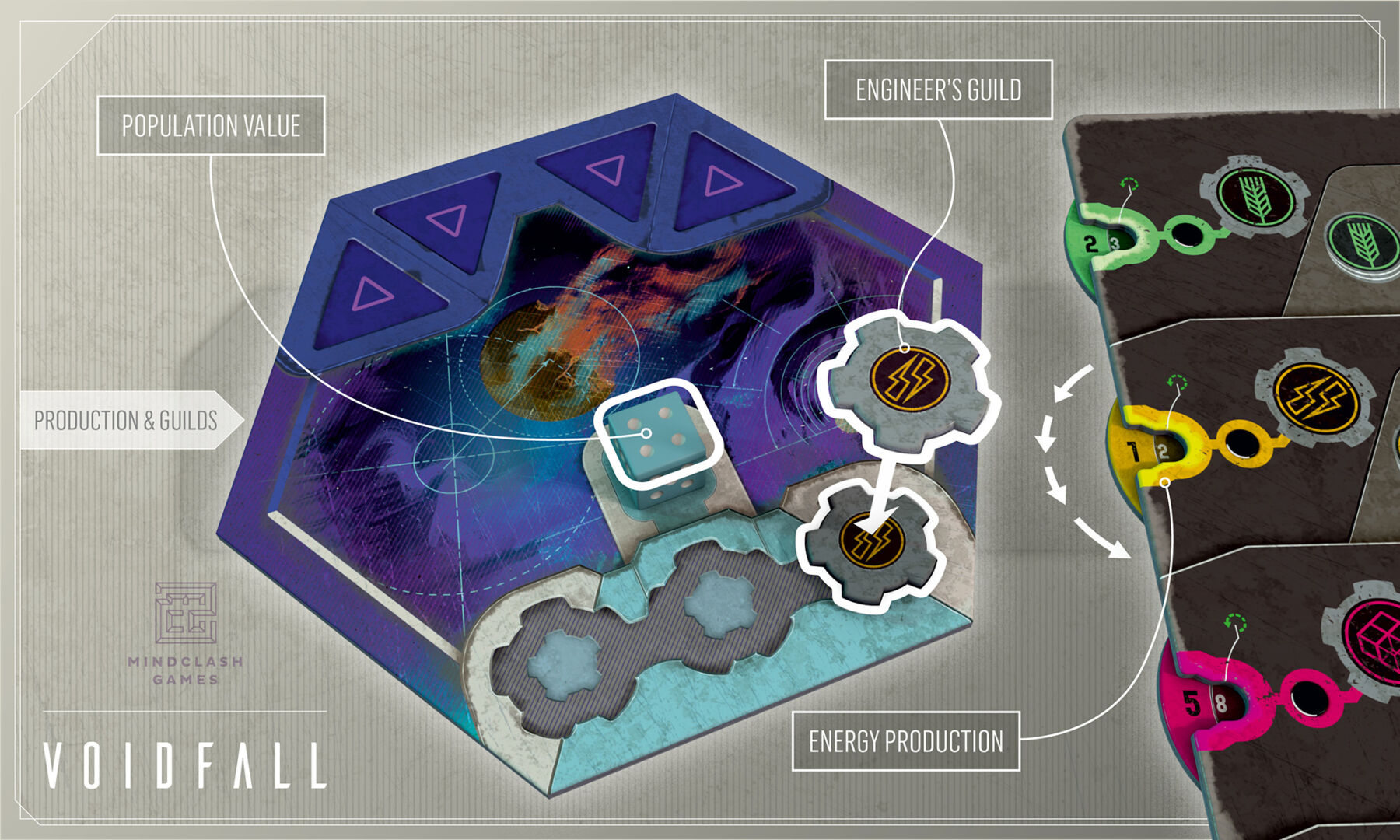
Military Installations
The other type of space in a sector are the triangular shaped ones. These are for your military Installations that you can deploy into the sector. They come in three types:
- Sector defences will provide protection for your sectors against invading enemy fleets
- Starbases will do the job of both a sector defence and a shipyard, and will help you welcome the masses fleeing from the Voidborn’s corruption: when built in corrupted sectors it will cleanse the draining reach of the Voidborn, when built in pure sectors it will increase your population further.
- Shipyards will allow you to deploy your mighty fleets you need to expand into new sectors
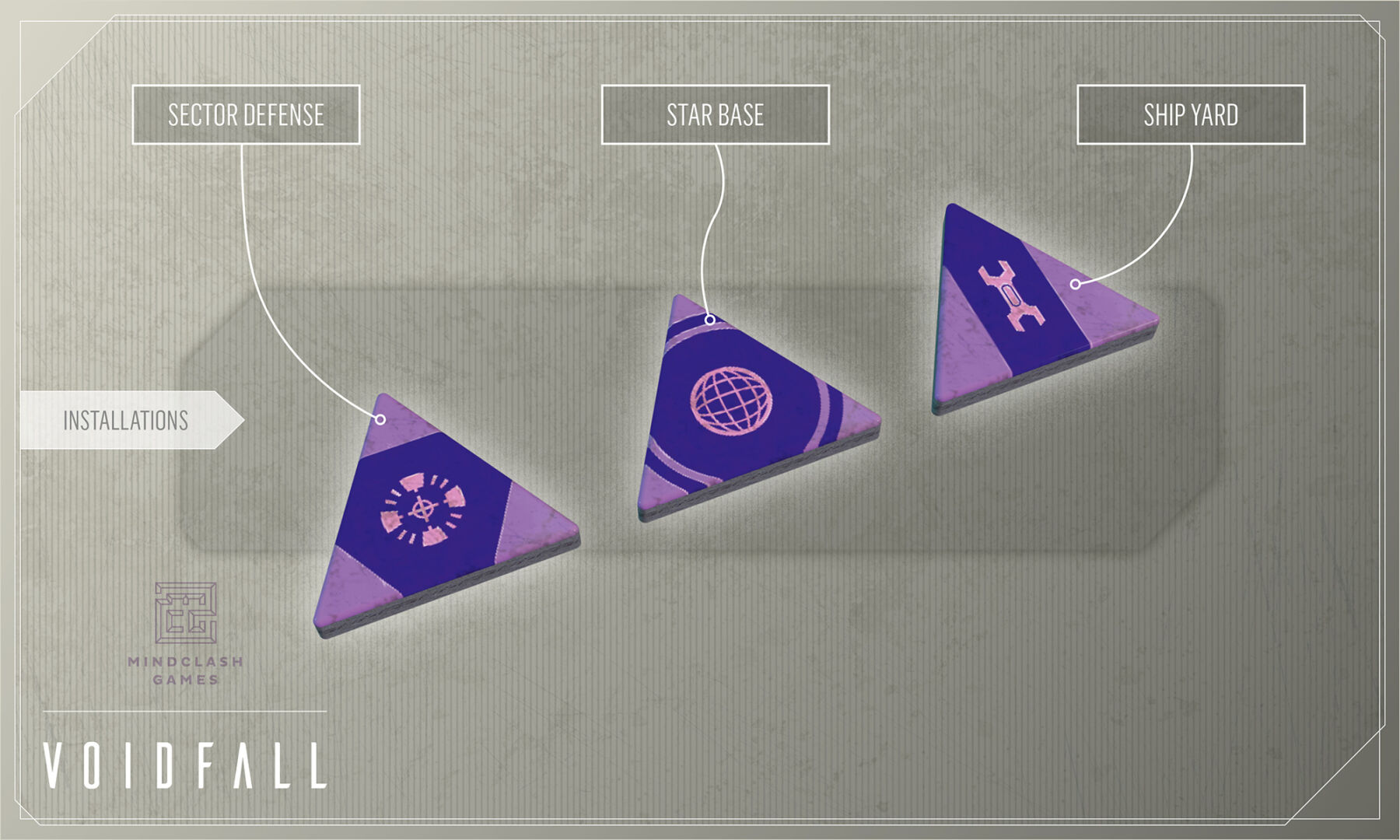
As you can see, the Installations function quite differently from the Guilds, as they provide various benefits for your Great House’s military strength. How they actually work will be discussed in a later entry of the Voidfall Design Spotlights.
In future spotlights we will tell you how you go about choosing and resolving actions of your Focus cards, establish your Guilds, build your Installations, then exploit their mighty capabilities allowing you to reinforce your fleets, expand your empire, and ultimately push back the corruption of the Voidborn.
Thank you very much for reading and please feel free to share your thoughts on boardgamegeek.com!
Nigel & David